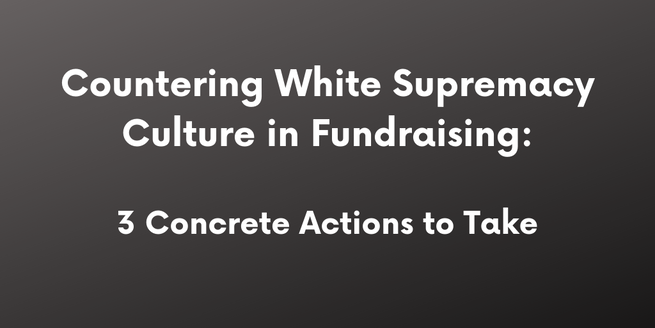|
Once we have acknowledged that white supremacy culture permeates all aspects of society, even in well-meaning and/or liberal institutions, we are left wondering what actions we can take to practically and meaningfully to combat this? Note: White supremacy culture is not limited to extremists like white nationalists. White supremacy culture is the foundational assumption in our country that white culture is the default and white culture is neutral, correct, and without bias. Here are three specific and concrete ways that fundraisers can take action to counter white supremacy culture in their work: HAVE WELL-CRAFTED AND STRONG GIFT ACCEPTANCE AND NAMING POLICIES Some donors will make attempts to exert unwelcome or even unethical levels of control at an organization. (See Season 1, Episode 10 of Dear White People on Netflix for an excellent example.) Non-profits must have strong value and mission statements which are supported by clear and coherent gift acceptance policies. If a donor attempts to sway the organization away from its mission and values, the policies must clearly lay out the conditions and process of refusing or returning the gift. Furthermore, naming policies for buildings, funds, and programs should articulate that the institution reserves the right to remove the donor’s name should that donor end up engaged in hate-based controversy or illegal activity. But, if your organization does not already have board-endorsed policies that assist in countering white supremacy culture, you’ll have a difficult time getting those policies approved if you don’t have people of color on your board. Which brings me to my second point . . . NOMINATE PEOPLE OF COLOR FOR YOUR BOARDAsk questions about the board nomination process. Repeatedly discuss board diversity in staff meetings. If you can nominate potential board members (and you should be allowed to participate in this process), nominate people of color. While you are at it, nominate queer people, women, and other representatives of other marginalized groups for board service. Always ask, who is not at the table? Encourage leadership and current board members to ask that same question. Asking it once is not enough. We must make it a conscious, constant practice. ADVOCATE FOR YOUR ORGANIZATION TO INVEST RESPONSIBLY Bring up the topic of divestment in your institution. Moving endowments out of funds that invest in private prisons is a good start. Look into ESG (Environmental, Social and Good Governance funds) and recommend that your organization move the entire endowment into responsible investment plans. This is the right thing to do and will show that your institution lives out its values. It is a concrete and meaningful step to take that will show donors that your organization is more than just a thoughtful press release when it comes to issues of race. This will attract like-minded donors to your cause.
This is just the tip of the iceberg. But these three steps are a good place to start. What other ways can we, as fundraisers, act and move things in the direction of the beloved community? Let me know in the comments. And subscribe to my FUNdraising Friday newsletter to keep the conversation going. Sincerely,
Gerard Ritier
5/8/2024 05:37:05 am
Hi everyone, I come with goodnews on how you can win the lottery. Winning the lottery was a dream come through for me and this was made possible with the help of Dr Kumar lottery winning numbers. All my years of playing the lottery I was unable to win on my own and online tips could not help me as well. I keep trying and also researching on how I can improve my chances of winning and I came across a lot of comments about Dr Kumar lottery winning numbers which have indeed made a lot of people lottery winners. I also contacted Dr Kumar by email and requested for my winning numbers which he responded to and sent me the winning numbers which I played and won the EuroMillions jackpot. You can contact Dr Kumar on email: [email protected] or WhatsApp +2347051705853 to send you your lottery winning numbers. This is the only way you can win the lottery by contacting Dr Kumar to send you the winning numbers. Comments are closed.
|
Jessica Cloud, CFREI've been called the Tasmanian Devil of fundraising and I'm here to talk shop with you. Archives
June 2024
Categories
All
|



 RSS Feed
RSS Feed
